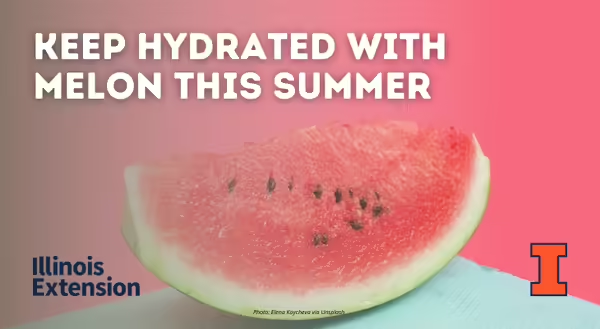
Melon is one the most sought-after fruit of the summer. Watermelon, muskmelon and honeydew all contain about 90 percent water, making them a popular sweet, juicy fruit for summer barbecues. If you’ve ever been confused about the difference between a muskmelon or a cantaloupe, you’re not alone. The terms are used interchangeably, but they are not technically the same thing. Truth be told, those cantaloupes you’ve been purchasing at the store are actually muskmelons, as a true cantaloupe is smaller and not grown in the U.S. Muskmelon is the umbrella term used to describe melons sweet in flavor, including the orange flesh melons and the green flesh melons, or honeydew. Basically, all cantaloupes are muskmelons, but not all muskmelons are cantaloupes. Phew! Now that we got that cleared up, let’s talk about watermelon.
Watermelon is not a muskmelon, but it belongs to the same Cucurbitaceae family as muskmelons. It contains potassium, vitamins A and C, and is a good source of lycopene, a powerful antioxidant that may be effective in preventing some forms of cancer and heart disease. Orange-fleshed muskmelon also contain high amounts of vitamins A and C, more so than honeydew. All melons have multiple uses. They are great for snacking and can be served in the rind, cut out of the rind into chunks, or scooped out with a melon baller. Use them in sweet dishes, such as fruit salad or smoothies, or pair them with salty ingredients, such as feta cheese, prosciutto or pickled with salt and vinegar. Wash melon, particularly the webbed cantaloupe, really well with a vegetable brush and water, as the outer rind can harbor bacteria. Store uncut at room temperature for up to 1 week but refrigerate once cut. Keep hydrated with melon this summer!
Summer Watermelon Salad (Printable PDF)
5 cups cubed watermelon
1 ½ cups diced English cucumber
6 fresh mint leaves, torn
6 fresh basil leaves, torn
¼ cup crumbled feta cheese (optional)
Honey Vinaigrette
1 Tablespoon honey
1 Tablespoon lime juice
2 teaspoons olive oil
Pinch of salt
Wash hands. In a small bowl, combine honey, lime juice, salt, and drizzle in olive oil while whisking. Set aside. In a large bowl, combine watermelon, cucumber, mint and basil. Pour the vinaigrette over the watermelon salad, and gently toss to combine. Top with feta cheese and serve.
Yield: 4 servings
Nutrition Facts per serving (with feta): 120 calories,4.5 grams fat, 160 milligrams sodium, 20 grams carbohydrate, 1 gram dietary fiber, 3 grams protein
Sources:
University of Illinois Extension, Watch Your Garden Grow. https://go.illinois.edu/veggies
University of Arkansas Extension, Carla Due. “What’s the difference between cantaloupe and honeydew melon”
Texas A&M Agrilife Extension, Joseph Masabni and Patrick Lillard. “Melons”